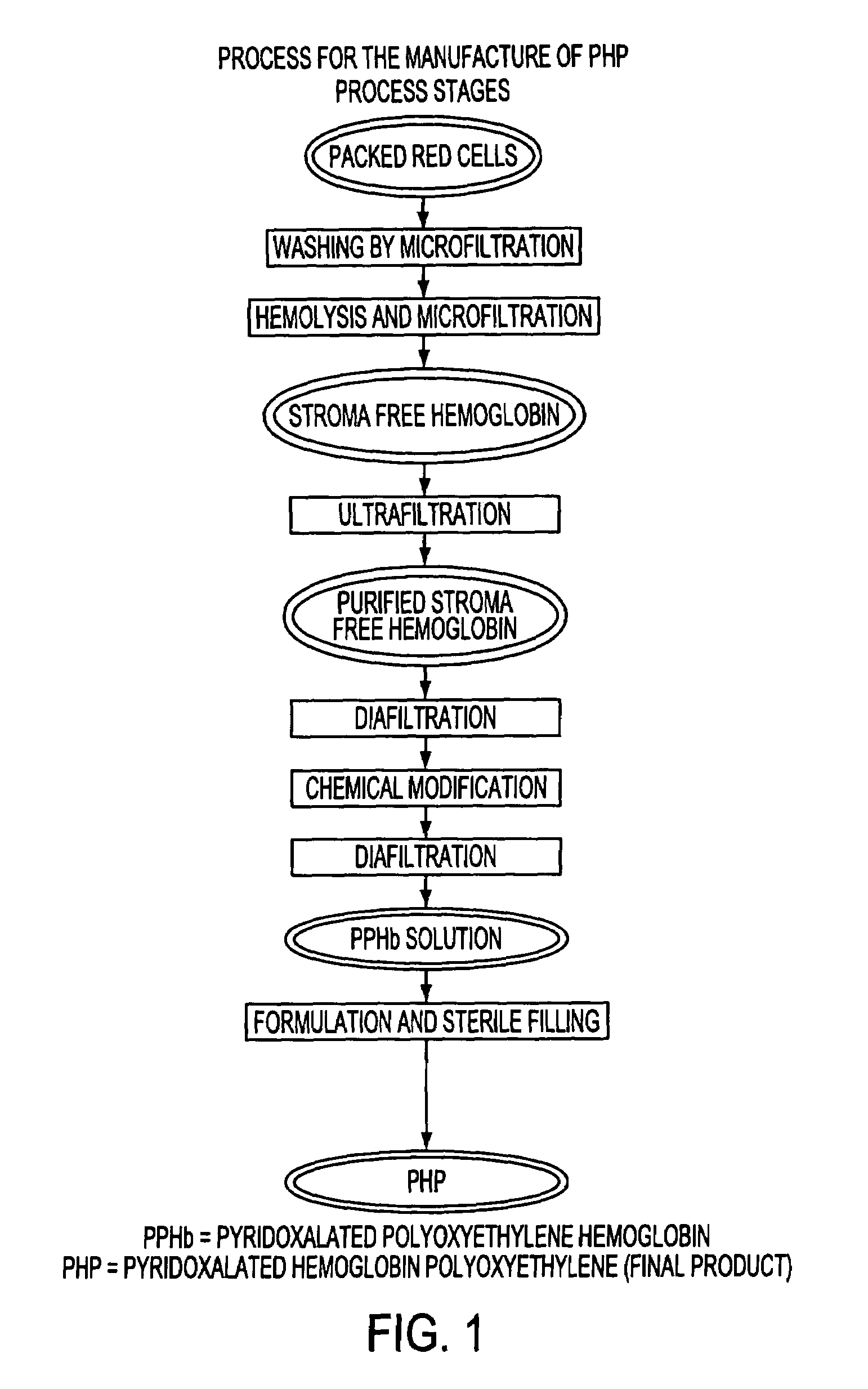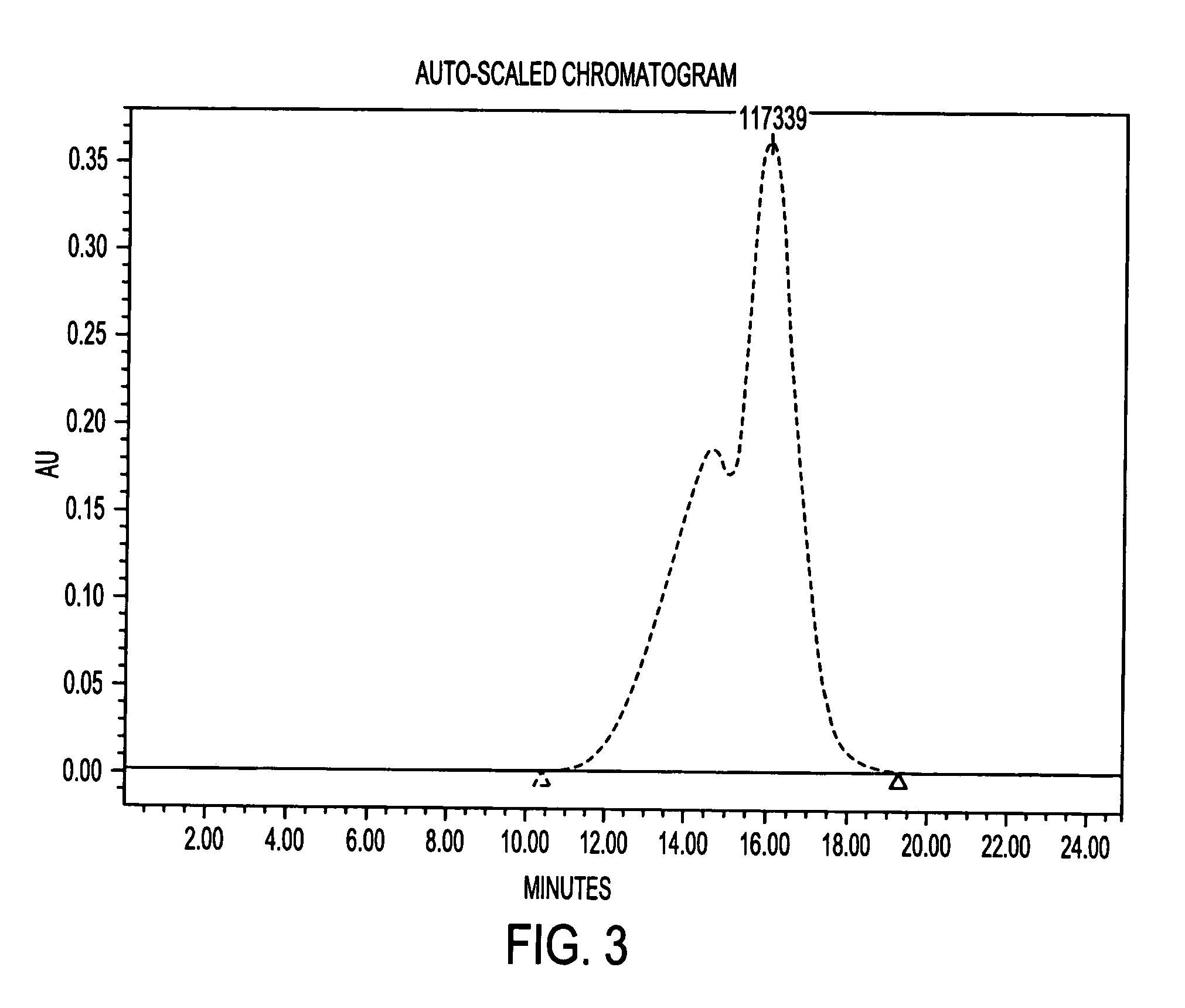Methods for purification of an activated PEG solution and for the synthesis of a modified hemoglobin solution
a technology of activated polyethylene glycol and purification method, which is applied in the direction of peptides, enzymology, drug compositions, etc., can solve the problems of contaminating the whole blood, affecting the safety or efficacy of drugs, and other tissue damage, so as to reduce the levels of contaminants and reduce the level of contaminants
- Summary
- Abstract
- Description
- Claims
- Application Information
AI Technical Summary
Benefits of technology
Problems solved by technology
Method used
Image
Examples
example 1
Assay of Bioburden Reduction in a Filtered POE Solution
[0044]100,7 grams of 3000 MW POE were dissolved in 300 ml of 95% ethanol and 240 ml of the resulting solution were filtered through a 47 mm diameter, 0.2 μm Posidyne® filter under positive pressure. The filtrate was collected in a sterile glass jar and samples were removed, diluted, and filtered through a Milliflex® filter unit for enumeration of bioburden. The samples were plated on sterile R2A agar and incubated for 4 days at 30–35° C. See, for example, Official Methods of Analysis of AOAC International (1995) 17th ed., 17.2.05 Official Method 986.32 or 17.3.08 Official Method 983.25. The POE solution contained 151 CFU / ml prior to filtration and 0 CFU / ml after filtration.
example 2
A. Assay of Endotoxln Reduction in a Filtered POE / Ethanol Solution
[0045]1 ml of purified E. coli LPS endotoxin (Charles Rivera Endosafe®) was added to 435 ml of a 3000 MW POE / ethanol (1:3 w / v) solution, the solution was sampled and then passed through a 47 mm diameter, 0.2 μm Posidyne® filter under positive pressure and collected into a pyrogen-free glass bottle. The filtrate was sampled and both the starting pool and filtrate pool samples were diluted into endotoxin-free water. The endotoxin content of each dilution was determined by a kinetic turbidimetrie LAb assay. The spliced starting pool contained 1,009,200 EU and the filtrate contained 346,375 EU. Thus 662,825 EU were removed by the filter.
B. Assay of Endotoxin Reduction in a Filtered POE / Methanol Solution
[0046]Approximately 2 million units of purified E. coli LPS endotoxin was added to 12 ml of a 3000 MW POE / methanol (1:3 w / v) solution, the solution was sampled and 10 ml were passed through a 47 mm diameter, 0.2 μm, Posidyn...
example 3
Stability of POE in Ethanol
[0048]POE was dissolved in ethanol (1:3 w / v) and aliquoted into a glass vial. At various timepoints an aliquot was removed from the vial and the POE was reacted with ammonium hypoxide. Samples from each timepoint were diluted to 1 mg / ml and analyzed by HPLC to determine the percent activity of the POE in solution. The results are shown below in Table 1.
[0049]
TABLE 1Stability of POE in EthanolTime (hr)Activity (%)097.60.597.6197.3296.8396.0495.82485.9
PUM
| Property | Measurement | Unit |
|---|---|---|
| diameter | aaaaa | aaaaa |
| diameter | aaaaa | aaaaa |
| area | aaaaa | aaaaa |
Abstract
Description
Claims
Application Information
 Login to View More
Login to View More - R&D
- Intellectual Property
- Life Sciences
- Materials
- Tech Scout
- Unparalleled Data Quality
- Higher Quality Content
- 60% Fewer Hallucinations
Browse by: Latest US Patents, China's latest patents, Technical Efficacy Thesaurus, Application Domain, Technology Topic, Popular Technical Reports.
© 2025 PatSnap. All rights reserved.Legal|Privacy policy|Modern Slavery Act Transparency Statement|Sitemap|About US| Contact US: help@patsnap.com



